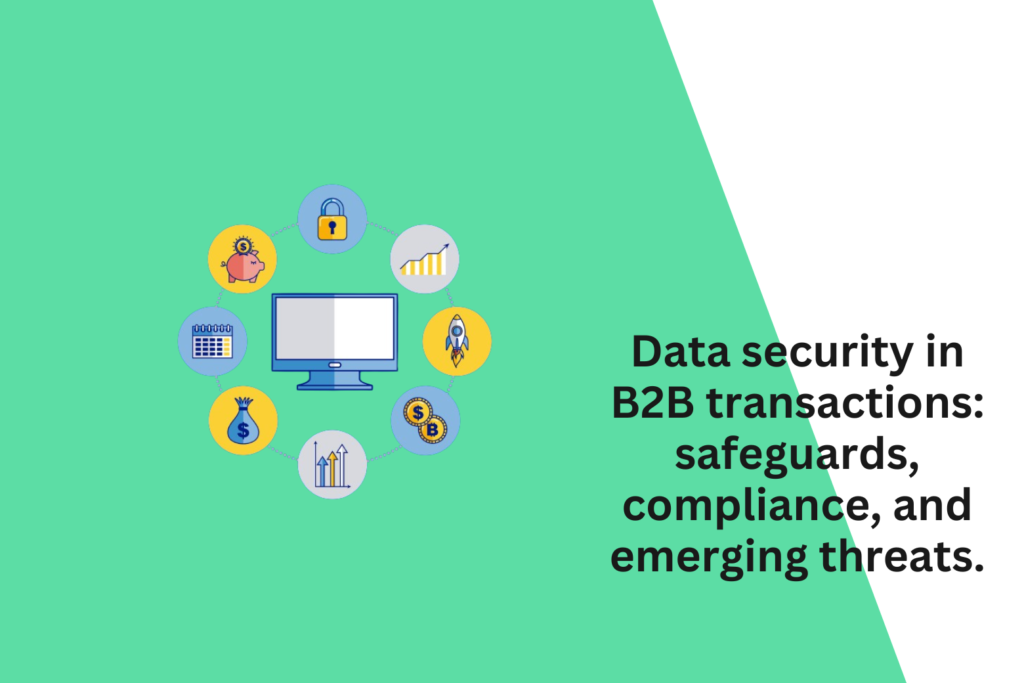
Data security in B2B transactions is paramount to protect sensitive information, maintain trust, and comply with regulatory standards. Here are key considerations for ensuring data security, including safeguards, compliance measures, and awareness of emerging threats:
Safeguards for Data Security:
Encryption:
- Utilize strong encryption protocols to protect data during transmission. Secure Sockets Layer (SSL) or Transport Layer Security (TLS) encryption is essential for securing data exchanged between systems.
Access Controls:
- Implement strict access controls to ensure that only authorized personnel have access to sensitive data. Use role-based access mechanisms to limit access based on job roles and responsibilities.
Firewalls and Intrusion Detection Systems:
- Deploy firewalls and intrusion detection systems to monitor and control network traffic. These tools help detect and prevent unauthorized access or malicious activities.
Multi-Factor Authentication (MFA):
- Enforce multi-factor authentication for user access. This adds an extra layer of security by requiring users to authenticate their identity through multiple verification methods.
Regular Security Audits:
- Conduct regular security audits and vulnerability assessments to identify and address potential weaknesses in systems and networks.
Secure Data Storage:
- Store sensitive data securely using encryption and access controls. Implement secure storage practices to protect data both at rest and in transit.
Employee Training:
- Provide comprehensive training to employees on data security best practices. Employees should be aware of the risks of social engineering, phishing attacks, and the importance of safeguarding sensitive information.
Data Backups:
- Regularly back up critical data to prevent data loss in the event of a security incident. Ensure that backup systems are secure and regularly tested for reliability.
Compliance Measures:
GDPR and Data Protection Regulations:
- Understand and comply with data protection regulations, such as the General Data Protection Regulation (GDPR). This includes obtaining consent for data processing, ensuring data portability, and protecting the privacy rights of individuals.
HIPAA Compliance (If Applicable):
- If dealing with healthcare-related data, comply with the Health Insurance Portability and Accountability Act (HIPAA) regulations. This includes safeguarding the confidentiality and integrity of health information.
Payment Card Industry Data Security Standard (PCI DSS):
- If handling payment card information, adhere to the PCI DSS standards. This involves secure handling of cardholder data and compliance with specific security requirements.
ISO/IEC 27001 Certification:
- Consider obtaining ISO/IEC 27001 certification, which is a widely recognized standard for information security management systems. It provides a framework for establishing, implementing, maintaining, and continually improving information security management.
Vendor Risk Management:
- Assess and manage the security risks associated with third-party vendors. Ensure that vendors comply with relevant data security standards and have robust security measures in place.
Incident Response Plan:
- Develop and regularly update an incident response plan. This plan should outline the steps to be taken in the event of a data breach or security incident.
Emerging Threats:
Ransomware Attacks:
- Be vigilant against ransomware attacks that can encrypt data and demand payment for its release. Regularly update security software, conduct employee training, and implement email filtering to prevent phishing attempts.
Supply Chain Attacks:
- Guard against supply chain attacks where attackers target vulnerabilities in the supply chain to compromise systems. Implement robust supplier risk management practices.
Zero-Day Exploits:
- Stay informed about emerging vulnerabilities and zero-day exploits. Promptly apply security patches and updates to address known vulnerabilities in software and systems.
Social Engineering and Phishing:
- Educate employees about social engineering and phishing tactics. Implement email filtering solutions and conduct simulated phishing exercises to enhance awareness.
Insider Threats:
- Mitigate insider threats by implementing access controls, monitoring employee activities, and providing training on the importance of data security.
Advanced Persistent Threats (APTs):
- Be aware of APTs that involve targeted and sophisticated attacks over an extended period. Implement advanced threat detection systems and conduct regular security assessments.
IoT Security Risks:
- If utilizing IoT devices, address security risks associated with these devices. Implement secure configurations, regularly update firmware, and segment IoT networks from critical business systems.
Continuous monitoring, proactive measures, and a comprehensive approach to data security are essential to mitigate risks and protect sensitive information in B2B transactions. Staying abreast of emerging threats and evolving security standards is crucial to maintaining a robust data security posture.



